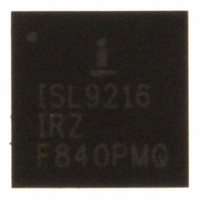ISL9216IRZ Intersil, ISL9216IRZ Datasheet - Page 22

ISL9216IRZ
Manufacturer Part Number
ISL9216IRZ
Description
IC MULTI-CELL LI-ION PROT 32-QFN
Manufacturer
Intersil
Datasheet
1.ISL9216IRZ.pdf
(33 pages)
Specifications of ISL9216IRZ
Function
Battery Monitor
Battery Type
Lithium-Ion (Li-Ion)
Voltage - Supply
9.2 V ~ 31 V
Operating Temperature
-40°C ~ 85°C
Mounting Type
Surface Mount
Package / Case
32-VQFN Exposed Pad, 32-HVQFN, 32-SQFN, 32-DHVQFN
Lead Free Status / RoHS Status
Lead free / RoHS Compliant
Available stocks
Company
Part Number
Manufacturer
Quantity
Price
Company:
Part Number:
ISL9216IRZ
Manufacturer:
BROADCOM
Quantity:
1 000
Company:
Part Number:
ISL9216IRZ
Manufacturer:
Intersil
Quantity:
802
Part Number:
ISL9216IRZ
Manufacturer:
INTERSIL
Quantity:
20 000
OVERCURRENT SAFETY FUNCTIONS
The ISL9216 continually monitors the discharge current by
monitoring the voltage at the CSENSE and DSENSE pins. If
that voltage exceeds a selected value for a time exceeding a
selected delay, then the device enters an overcurrent or short
circuit protection mode. In these modes, the ISL9216
automatically turns off both power FETs and hence prevents
current from flowing through the terminals P+ and P-.
The voltage thresholds and the response times of the
overcurrent protection circuits are selectable for discharge
overcurrent, charge overcurrent, and discharge short circuit
conditions. The specific settings are determined by bits in
the “DISCHARGE SET CONFIGURATION REGISTER
(ADDR: 05H)” on page 18, and “CHARGE/TIME SCALE
CONFIGURATION REGISTER (ADDR: 06H)” on page 19.
(See also “REGISTERS” on page 14).
In an overcurrent condition, the ISL9216 automatically turns off
the voltage on CFET and DFET pins. The DFET output drives
the discharge FET gate low, turning off the FET quickly. The
CFET output turns off and allows the gate of the charge FET to
be pulled low through a resistor.
By turning off the FETs the ISL9216 prevents damage to the
battery pack caused by excessive current into or out of the cells
(as in the case of a faulty charger or short circuit condition).
When the ISL9216 detects a discharge overcurrent condition,
the ISL9216 turns off both power FETs and sets the DOC bit.
(When the FETs are turned off, the DFET and CFET bits are
also reset). The automatic response to overcurrent during
discharge is prevented by setting the DENOCD bit to “1”. The
external microcontroller can turn on the FETs at any time to
recover from this condition, but it would usually turn on the load
monitor function (by setting the LDMONEN bit) and monitor the
LDFAIL bit to detect that the overcurrent condition has been
removed.
When the ISL9216 detects a discharge short circuit condition,
both power FETs are turned off and DSC bit is set. (When the
FETs are turned off, the DFET and CFET bits are also reset).
The automatic response to short circuit during discharge is
prevented by setting the DENSCD bit to “1”. The external
microcontroller can turn on the FETs at any time to recover from
this condition, but it would usually turn on the load monitor
function (by setting the LDMONEN bit) and monitor the LDFAIL
bit to detect that the overcurrent condition has been removed.
When the ISL9216 detects a charge overcurrent condition, both
power FETs are turned off and COC bit is set. (When the FETs
are turned off, the DFET and CFET bits are also reset). The
automatic response to overcurrent during discharge is
prevented by setting the DENOCC bit to “1”. The external
microcontroller can turn on the FETs at any time to recover from
this condition, but it would usually wait to do this until the cell
voltages are not over charged and that the overcurrent
condition has been removed. Or, the microcontroller could wait
22
ISL9216, ISL9217
until the pack is removed from the charger and then re-
attached.
An alternative method of providing the protection function, if
desired by the designer, is to turn off the automatic safety
response. In this case, the ISL9216 device still monitors the
conditions and sets the status bits, but takes no action in
overcurrent or short circuit conditions. Safety of the pack
depends, instead, on the microcontroller to send commands to
the ISL9216 to turn off the FETs.
To facilitate a microcontroller response to an overcurrent
condition, especially if the microcontroller is in a low power
state, a charge overcurrent flag (COC), a discharge overcurrent
flag (DOC), or the short circuit flag (DSC) being set causes the
ISL9216 TEMP3V output to turn on and pull high. (See
Figure 5). This output can be used as an external interrupt by
the microcontroller to wake-up quickly to handle the overcurrent
condition.
LOAD MONITORING
The load monitor function in the ISL9216 (see Figure 4) is used
primarily to detect that the load has been removed following an
overcurrent or short circuit condition during discharge. This can
be used in a control algorithm to prevent the FETs from turning
on while the overload or short circuit condition remains.
The load monitor can also be used by the microcontroller
algorithms after an undervoltage condition on any cells
causes the FETs to turn off. Use of the load monitor prevents
the FETs from turning on while the load is still present. This
minimizes the possible “oscillations” that can occur when a
load is applied in a low capacity pack. It can also be part of a
system protection mechanism to prevent the load from
turning on automatically - i.e. some action must be taken
before the pack is again turned on.
LDFAIL
=1 if VMON > V
=0 if VMON ≤ V
VSS
ISL9216
LDMONEN
FIGURE 4. LOAD MONITOR CIRCUIT
VMONH
VMONL
OPEN
V
REF
DFET
VSS
36V
VMON
November 2, 2007
R
1
R
L
FN6488.1
P+
P-













